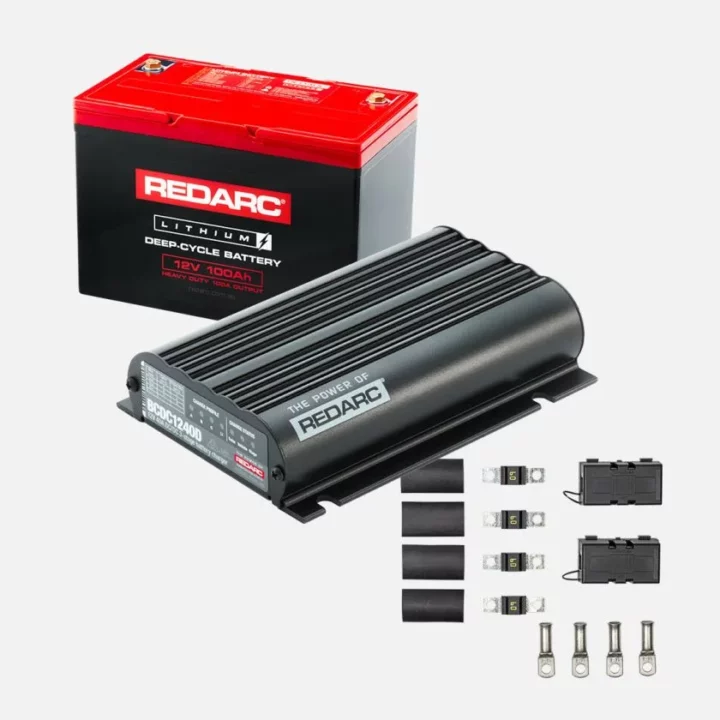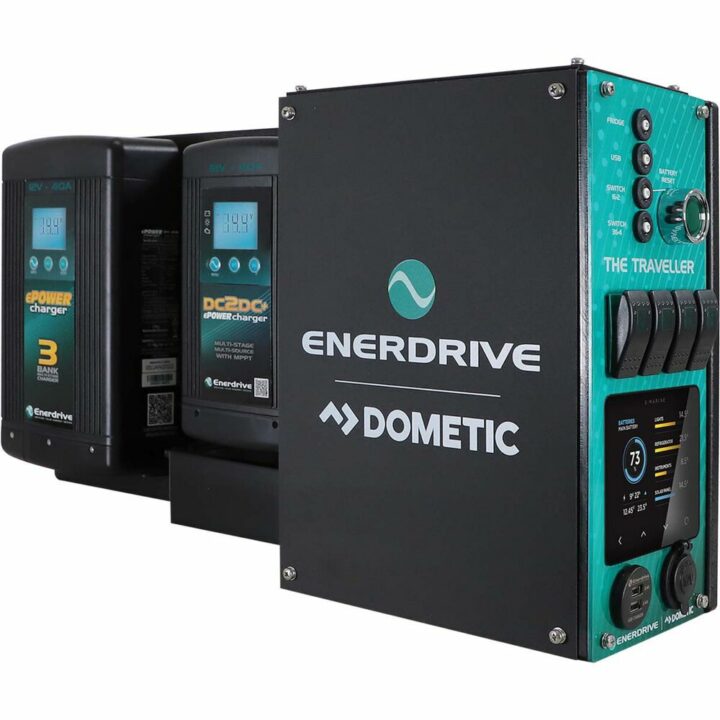Recently, a reader asked how to provide off-grid power to a Starlink internet device. Given that our expectations of a weekend away now include home comforts, such as a coffee machine and a portable fridge, it’s helpful to know how to power all manner of technology away from home. These expectations grow to long-term RV travellers who want to run induction cooktops, air fryers, and even air conditioners whilst off-grid.
There are plenty of off-grid power options for camping, travelling, and anything in between. As we run through the technology, we’ll also let you know what’s best for your situation.
Off-grid power contents
- What you need to know about off-grid power
- How has off-grid living changed?
- Which off-grid power solution is right for you?
- Off-grid charging options
- Which off-grid power solution should you use?
What you need to know about off-grid power
As our desire for off-grid comforts grows, so does our need to provide more electricity without the luxury of mains-connected power. By off-grid, we refer to being remote and unable to connect to a mains 240-volt power supply. Yes, a night in a caravan park can include a powered site that will provide 240 volts, like at home, to power your toys and potentially charge batteries.
To have electric devices off-grid, you need three things:
- A battery
- The ability to connect your electrical devices to the battery
- A method of charging your battery

Your vehicle will have a 12-volt battery, designed for a short, high load to turn a starter motor and run vehicle accessories when the engine is running. Car batteries are not designed to power long or deep-cycle power needs. Don’t use your car battery to power devices with the engine off, or you will not be able to start your car in the morning.
Most electric devices are designed to run off 12-volt DC (direct current) or 240-volt AC (alternating current in Australia). A battery will be DC and is most likely 12 volts. You can run a 240-volt appliance from a battery using an inverter, which converts DC to AC. This process does come with a loss of power of around 10%. An inverter will need to be right-sized to power your 240-volt appliance. A 2000-watt coffee machine will need a >2000-watt inverter. The label on the bottom of your 240-volt appliance will indicate how many watts it needs.
Battery technology has advanced, and a modern lithium battery is the only technology we will discuss here. A Lithium battery has the advantage of being lightweight, holding more power, having a longer life and a disadvantage of being expensive. There are two main types of Lithium batteries: Lithium and LiFePO4. LifePO4 batteries are safer and last longer but are more expensive.
The capacity of a battery is measured in Amp-hours Ah or Watt hours Wh. From school, Watts = Amps x Volts. A 100Ah 12-volt battery is equal to approximately 1280Wh. If we ran a 100-watt camping fridge, it, in theory, would run for 12 hours. In reality, because you cannot fully discharge a lithium battery thanks to inbuilt intelligence and electrical losses, you would get less than 10 hours.
To charge your battery, you will need a mains battery charger if 240 volts is available, and you can last when you do not. Alternatively, when off-grid, you can recharge batteries from solar panels, a portable petrol generator, or the alternator in your vehicle.
Power your Starlink from 12 volts
The off-the-shelf Starlink models require 240-volt AC power. A Starlink will consume approximately 1000Wh in 24 hours whilst operational. Power solutions for a Starlink include a DIY battery & 200w or larger inverter, an all-in-one power station solution such as the Bluetti AC180, or a custom-built DC power supply such as the StarPower solution (requires 12 volts).

If you want to power a Starlink, why stop there? We could take many luxuries with us, so let’s explore that some more.
How has off-grid living changed?
We can go back to basics, sleep in a swag, keep warm from the fire and see from the stars, but when given the choice of glamping, I know which one I would choose.
Some of the home comforts you can have with off-grid power:
- Internet and staying connected. Mobile broadband means you can stay connected in many areas, but Starlink means you can stay connected anywhere. National parks require online bookings, so how do you book without internet access?
- Smartphone, tablet or PC so you could work on the road
- TV to watch your team or favourite soap. Travellers no longer need an aerial; you can stream live TV or watch Netflix online.
- Music to keep the party going without flattening your car battery
- Power tools to repair or improve your setup.
- Fridge: the days of melted ice in the bottom of the esky are over with portable fridges keeping your food and drinks fresh and cold.
- Coffee machines are the latest fad off-grid to get you started in the morning. Equally, a blender may be your go.
- Fans to keep you cool and help you sleep at night
- Water pumps allow you to shower and easily handle the washing-up chores
- Lights and torches make a big difference beyond the campfire
- Induction or air fryer provides heat to cook your food without gas
- CPAP machines for those with sleep apnea
- Aircon is the holy grail of off-grid living, but you will need an expensive setup.
Which off-grid power solution is right for you?
Now that you have a taste for all the appliances you could run off-grid, it’s time to work out the balance of what you need and can afford.
Your solution must be the right size to run your appliance. Using our coffee machine example, you would need a solution capable of powering the machine around 2000W. Your battery also needs to be able to last until you are in a position to recharge it. A 100 Amp (1280WH battery) could run a coffee machine or electric drill for about 45 minutes, a CPAP machine for 20 hours, or a 10w light for 100 hours.
Off-grid power options:
- 12 volt only – cheapest solution
- 12-volt and 240-volt
Which can be
- DIY built from components – you need to be handy
- Professionally installed solution – most expensive
- Portable all-in-one solution – a power station bought off the shelf

With so many options, we have picked a few to help you start your journey and provide you with off-grid power. If you need help, a professionally installed solution will add between $1,000-$2,000 in labour.
Basic 12-volt solutions
- DIY Redarc Battery kit with 100Ah battery, 40Amp DCDC charger, and fuses $2,641
- DIY Renogy components 100Ah battery $500 20Ah DCDC charger $120 Total $620
(you would need to add fuses and cables.) - ITECHWORLD portable battery box 100AH 25Amp DCDC charger $1,200

- Bluetti B80 806Wh (63Ah) all in one 12v power station $999
- Bluetti B230 2048Wh (160Ah) all in one 12v power station $1,899
240-volt solutions
- DIY Enerdrive Adventurer System 2000W inverter, 200Ah battery, 40A DCDC Simarine screen $6,869

- DIY Renogy components 200Ah battery $1443 30Ah, 2000W inverter $320 DCDC charger $280
- Total $2043 (you would need to add fuses and cables)
- Ecoflow Delta Max Portable Power station 2000Wh (156AH) battery 2400W inverter $3,199
- Bluetti AC180 Portable Power station 1152Wh (90AH) battery 1800W inverter $1,499

- Bluetti AC200P Portable Power station 2000Wh (156AH) battery 2000W inverter $1,999
The cost will continue to rise as you add more and larger batteries to last longer, larger inverters to power more, and more charging options to recharge faster. If you want to run an off-grid aircon, you will need about 600Ah of batteries and deep pockets.
Off-grid charging options
You do not need many or large batteries if you can recharge your batteries whilst off-grid. Lithium batteries are expensive, so investing in a recharging solution can be more cost-effective and potentially enable you to stay off-grid indefinitely. Here are some of your options:

- Mains battery charger
Lithium batteries can be recharged quickly. You could recharge it in an hour if you have a 100Ah battery with a 100Amp charger. A 2Amp charger would take more than 2 days. An ideal solution would allow you to recharge whilst you sleep. - Petrol generator
Having the advantage of also being able to power your appliances, you are only limited by fuel. A 240-volt or 12-volt charger is still required. A 2000-watt generator would charge a 100Ah battery in under an hour. - Charging from your running vehicle
In its simplest form, you can draw 100 watts (8 Amps) from your car’s cigarette lighter, taking 15 hours to charge a 100Ah battery. To charge more quickly, a DCDC charger can be connected directly to your vehicle’s alternator, enabling 40 Amps charge, reducing this time to under 3 hours. - Solar Panels
As long as the sun shines, this limitless power source keeps your batteries topped up. Please read our guide to camping solar panels to fully understand their potential. Fixed or portable solar panels are the most likely solution to powering your off-grid exploits.
Which off-grid power solution should you use?
So far, I’ve explained all the ins and outs of off-grid power, which can be as complex or as simple as you want. In my view, it’s best to keep it simple with an all-in-one portable power station. I’ve reviewed several models recently and believe they are simple to use, require no setup, and, most importantly, can be easily moved from a vehicle to the house. They can power your Starlink in central Australia, power a circular saw on a metropolitan job site or keep your home fridge running during a blackout. A portable power station can be easily used to retrofit an old RV setup or a new setup all the same.
Portable power stations can be charged from solar panels, and some models also allow them to be used as uninterrupted power supplies, ensuring power consistency and expandable battery solutions to keep you running longer.








